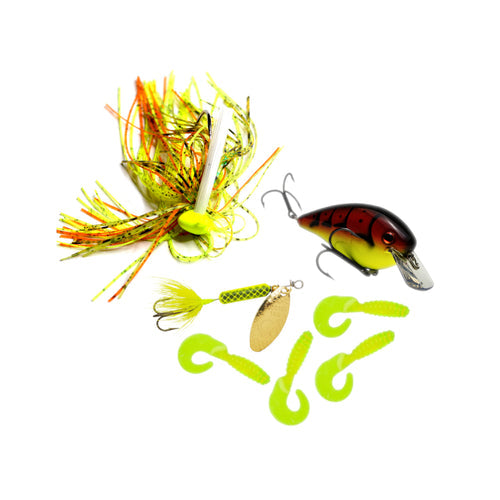
An Angler's Guide to Chartreuse Fishing Lures
Neil ColicchioShare
This is the second in a series of blog posts about lure selection. The series' primary focus is lure color, though I'll do my best to include some recommendations on specific lures or lure styles that really allow these colors to perform at their best. If you haven't already read part one of this series, check out my post on metal lures and metallic finishes.
While metal lures are my first choice in almost any freshwater fishing scenario, there are times when a metal finish quite literally does not shine. My most recent kayak fishing trip made me painfully aware of this. I started the day with a light cloud cover and warm, glassy water - a perfect setting to test the gold Kastmasters I received in my latest restock.
After an hour of slow but steady action and a couple of nice largemouth bass, the clouds thickened. I noticed the reflections on the water's surface disappearing and sensed that my luck was about to change. I stuck with my favorite gold casting spoons out of a mix of laziness and obstinacy, and that turned out to be a mistake. Except for one pint-sized perch -the kind that makes you wonder how it even got the hook in its mouth- the rest of the day was a bust.
At the end of the day, I loaded my kayak back onto my truck and draped my soaking wet jacket across the passenger seat. On the drive home, I began to reflect on what I could have done differently.
I had started the day with a Choppo tied onto my second rod, and despite scaring a couple of fish off of some cover, I had no success with topwater lures. Despite mostly fishing the gold Kastmaster on my main rod, I switched it up with a chrome and blue one for a bit and even changed to a silver Vibrax spinner for a short stretch. With most of the lake measuring less than six feet deep, I felt pretty confident that I'd covered the entire water column at some point during the day. One thing I hadn't adjusted much was my color selection, ultimately sticking to metal finishes on everything but the Choppo. Even that lure was a threadfin shad lookalike, which used a mix of blues, greens, blacks, and whites to create a non-metallic silver finish.
There are a few colors I could have tied on in an attempt to turn my day around. The first is orange, which I'll save for another post on early springtime colors. The second is chartreuse, that enigmatic color that sits somewhere between lime green and yellow.
Why Chartreuse?
1. High Visibility: Chartreuse is visible in almost any environment, and it is especially effective in stained water or other low-light conditions. It contrasts against water and bottom, making it easy for fish to spot from a distance.
2. Mimicry: There are conflicting opinions on this. Some believe that the color mimics the appearance of various prey items, triggering the predatory instincts of fish. Others claim that the bright colors might trigger reaction strikes from territorial spawning fish.
3. Availability: Almost every lure style from every manufacturer has a chartreuse option or one that features chartreuse accents from the classic Rooster Tail to your favorite crankbait and just about every shape of soft plastic lure.
When to Use Chartreuse Lures
In addition to being a great all-around lure color, there are several situations where chartreuse lures are must-have additions to your tackle selection.
1. Low Light Conditions: Early morning, late evening, and overcast days are perfect for using chartreuse lures. The bright color contrasts against darker skies and water, making it visible from a distance.
2. Murky or Stained Water: In waters with low visibility due to algae, sediment, or other particles, the color's high visibility cuts through the murk, making it easier for fish to locate your lure. Try a chartreuse lure in your favorite trout stream or after a rough patch of weather and watch how it draws strikes like nothing else can.
3. Deep Water Fishing: Chartreuse is also effective in deeper waters where light penetration is limited. The bright color remains visible as it descends, attracting fish that may be sitting in deeper holes or hiding below cover.
4. Warm Water Seasons: During the warmer months, when algae blooms, and water clarity can decrease, chartreuse lures can be particularly effective. Fish are more active and willing to chase down prey if they can detect it through the haze.
Tips for Using Chartreuse Lures
1. Pair with Natural Colors: In clearer water, consider using chartreuse in combination with more natural colors to avoid spooking fish. Colors like green pumpkin and black can create a subtler and more believable presentation.
2. Experiment with Different Lure Types: Don't be afraid to try chartreuse on various lure types. This tip applies to all colors; experiment with depth, retrieve speed, and fishing spot to find when chartreuse works best on your local waters.
3. Match the Hatch: Pay attention to the local forage. Are the fish feasting on yellow-green insects or baitfish? Tie on a chartreuse lure. Are you fishing for stockies in a silty stream? Powerbait is available in chartreuse!
To be totally honest, I've fished chartreuse lures for years because I've been lucky with them on a few occasions. I didn't keep fishing logs or analyze my fishing strategies when I first started; I just tried a bunch of things until something struck.
I've had the idea to write this post for a couple of months, so I did a lot of reading about the history of Chartreuse (the liqueur) and chartreuse (the color). I wanted to find out who introduced color to the fishing industry, what they were trying to mimic, or even something about the appearance of yellows and greens at different water depths. What I got was a lot of superstitious old anglers and an adage, "If it ain't chartreuse, it ain't no use."
Despite inconclusive findings on the use of chartreuse, two things are clear to me:
- Chartreuse is a major skunk deterrent, but nobody can really explain why.
- No matter the color, a successful catch relies on location, timing, presentation, and a fair bit of luck.
So keep a few colors on hand, don't be afraid to experiment, and trust your judgment. With practice, you'll know when your lure simply isn't getting the job done. You'll develop a feel for how deep and how far out the fish are based on where in your retrieve the strikes are happening. Remain vigilant, make good mental notes, and change it up once in a while. Until next time, tight lines and happy fishing!
Neil Colicchio
Owner, New Dawn Tackle Co.



